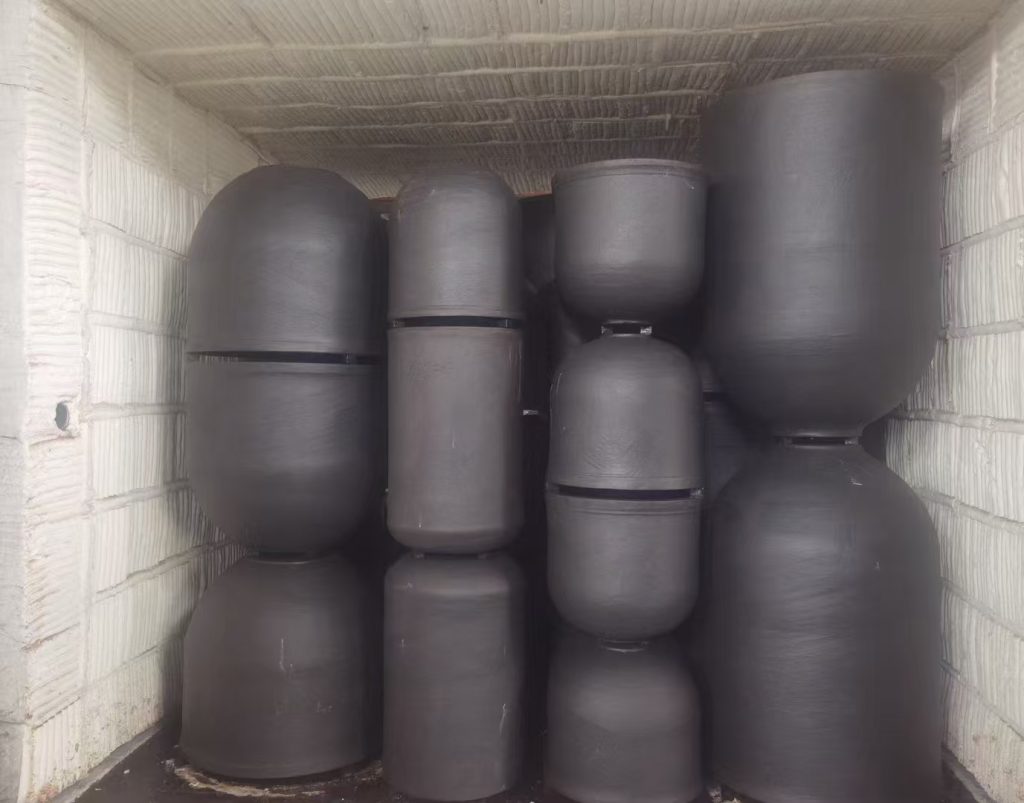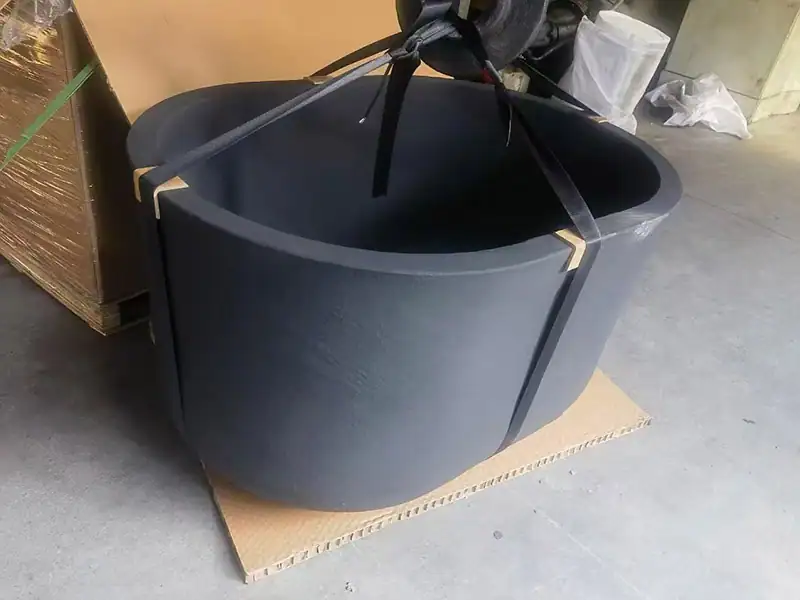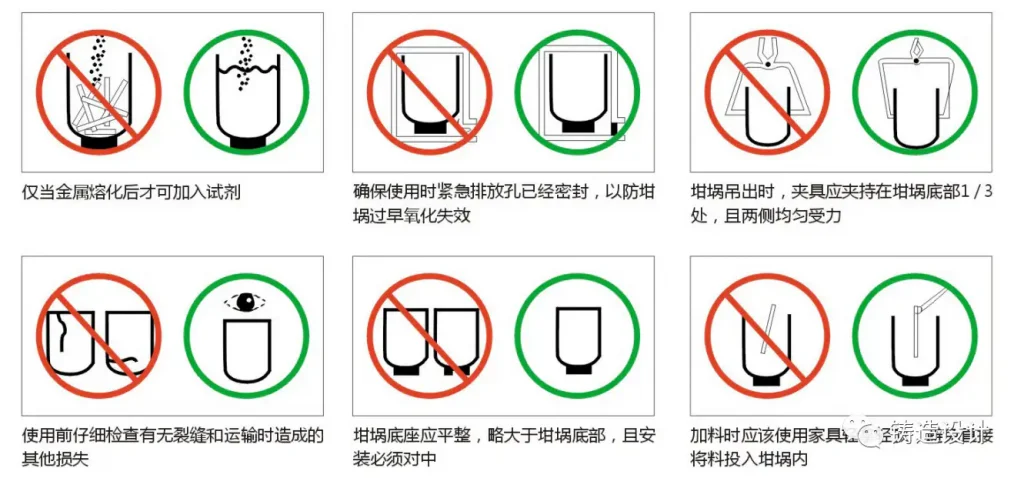Casting crucible (silicon carbide crucible, graphite crucible, etc.) use tutorial
Date: 2024-11-13 Categories: Blog Views: 1777
What is a casting crucible?
Crucibles are containers for metals with high melting points. (Gold 1064°C, silver 962°C, copper 1083.4°C, cast iron 1200°C, iron 1535°C, aluminum 660°C.)
Types of casting crucibles:

What are casting crucibles made of:
- Graphite Crucible : It refers to a kind of crucible made of graphite, clay, silica and wax stone. Graphite crucible is mainly used for melting non-ferrous metals and their alloys, such as copper, brass, gold, silver, zinc and lead.
- Quartz Crucible : The main chemical composition of quartz crucible is silicon dioxide. It has the advantages of high purity, strong temperature resistance, large size, high precision and good heat preservation. It is commonly used for pulling semiconductor materials such as large diameter single crystal silicon.
- Porcelain Crucible : Porcelain crucible is the main component of chemical laboratory supplies: alumina (45-55%), silicon dioxide. Maximum heat resistance is about 1200 degree Celsius. Suitable for melting samples of acidic substances such as K2S2O7.
- Corundum Crucible : Corundum crucible, the scientific name of alumina crucible, usually called the crucible with alumina content over 95% as corundum crucible. It consists of porous fused alumina, which is strong and resistant to melting. It is suitable for melting samples with weak alkalis as the melting agent.
- Metal Crucible The cast iron crucible is used to meltaluminumNickel crucibles are used for melting samples with NaOH, alkaline solvents, such as Na2o2, zinc alloys and other metals.
- Silicon Carbide Crucible : Silicon carbide crucibles are ceramic deep-bottomed bowl-like containers. Crucibles are necessary when heating solids over high heat. This is because it can withstand high temperatures better than glassware. Made of silicon carbide material, it has very high temperature resistance and can withstand very high temperature and pressure, and is not easy to be deformed and cracked. Silicon carbide crucibles also have good corrosion and heat resistance and are suitable for melting and sintering processes at high temperatures. Silicon carbide crucibles perform well in melting metals and alloys of high hardness and density, and their excellent performance ensures the stability and efficiency of the melting process.
Casting crucibles are mainly categorized by shape:

Round Crucible : The most common shape for most melting needs.
Square or rectangular crucibles : Metals are designed to meet specific requirements for easy handling and melting of specific shapes.
Special shapes of crucibles : e.g. V-type, U-type, etc., for specific melting processes or to meet special operating requirements.
Crucible furnace operation and maintenance procedures:
You must familiarize yourself with the principles, performance specifications and use of the equipment before using it.
Pre-work:
- Check the crucible for cracks, hoist lifting mechanism, ventilation and dust removal system is intact, confirm before working.
- The equipment is strictly prohibited from being overloaded, and flammable and explosive materials must not be placed 10 meters around the furnace.
- The charge must be preheated and kept dry, and the addition of explosive substances is strictly prohibited.
- The ventilation and dust removal system is not working properly and melting is not allowed.
- Do not overfill when pouring the liquid metal from the crucible into the package.
After work:
- At the end of the work, remove the remaining liquid metal from the crucible, place all parts in the non-working position and finally stop the fan and disconnect the power supply.
- Clean up the work site and sanitize it.
Maintenance and maintenance protocols:
- Check the furnace body and crucible for cracks and that the operating tools are complete and intact.
- Whether the lifting mechanism trolley travel is flexible, lifting mechanism wire rope, hook head is intact, whether the brake is sensitive and reliable.
- Whether the blower and piping are intact, whether the air volume delivered meets the melting requirements, and whether there is vibration and abnormal sound when working.
- Whether the exhaust smoke and dust removal fan is working normally, whether there is any abnormal phenomenon.
- Repair hoist lifting mechanism, wire ropes, and hooks for wear and replace or repair as necessary. Repairs or replaces brakes to ensure equipment and personal safety. Repairs blowers, dust fans, disassembles and cleans bearings to refuel, repairs leaking ventilation ducts, gas lines and valves.
- Remove motor bearings for oiling and test insulation resistance. Replace each electrical control system component as necessary to ensure the safety, sensitivity and reliability of the electrical control system. Grounding of all systems must be reliable.
Cast Crucible Notes:
- 1、Store the crucible in a ventilated and dry environment to avoid the influence of moisture.
- 2、The crucible should be gently held and put down in the process of transportation, it is forbidden to fall down and do not roll, so as not to damage the protective layer on the surface of the crucible.
- 3、Bake the crucible in advance before use. The baking temperature rises slowly from low to high, and keep turning the crucible to make it heat evenly and eliminate the moisture in the crucible body, and the preheating temperature gradually rises to more than 500°.
- 4、Crucible furnace should be matched with crucible, up and down and around the gap should meet the requirements, the furnace cover shall not be pressed on the crucible body.
- 5、Use should avoid the flame directly spraying the crucible body and spraying to the crucible base.
- 6, add materials should be added slowly, preferably crushed materials, large materials do not load too much, too tight, so as not to crack the crucible.
- 7. Crucible tongs used for mounting and discharging the crucible should be consistent with the appearance of the crucible so as not to pinch the crucible.
- 8. It is better to use the crucible continuously in order to better utilize its high performance.
- 9、The melting process needs to control the input of additives, overuse will reduce the service life of the crucible.
- 10、When using the crucible, the crucible should be rotated regularly to make it heat evenly and prolong the use.
- 11、When removing the slag and sticky coke on the inner and outer walls of the crucible, it should be knocked gently so as not to damage the crucible.


Try HeXin now!
Frequently Asked Questions (FAQs)
Do you use cast iron as a crucible for production?
Yes. Cast iron crucibles used to be commonly used in Chinese aluminum die casting plants, but cast iron crucibles have a shorter service life and increase the iron content of the aluminum solution. Nowadays, graphite crucibles and silicon carbide crucibles are commonly used by aluminum low-die casting manufacturers.


















